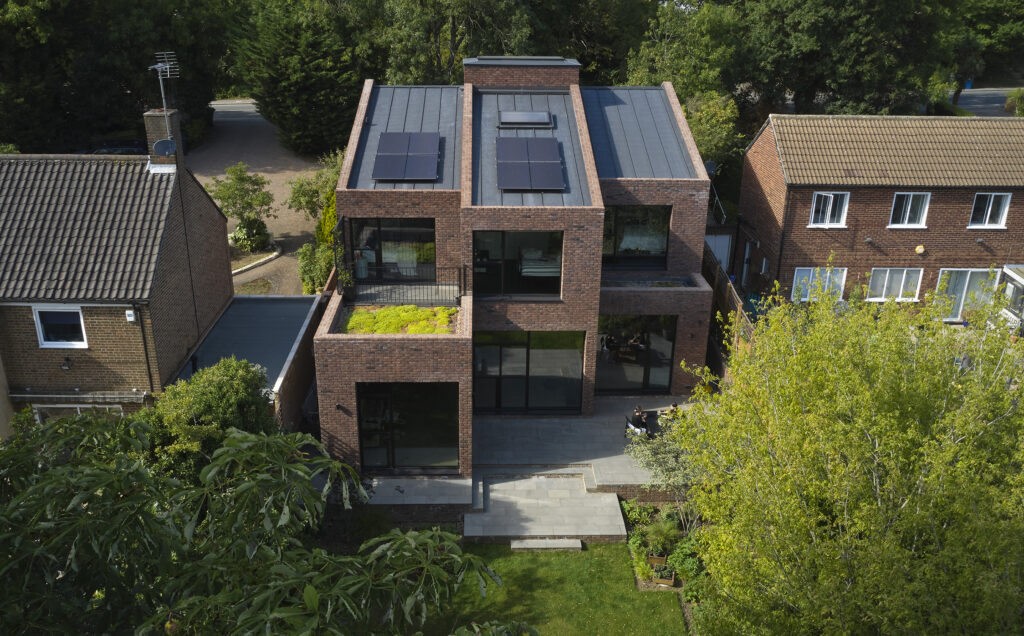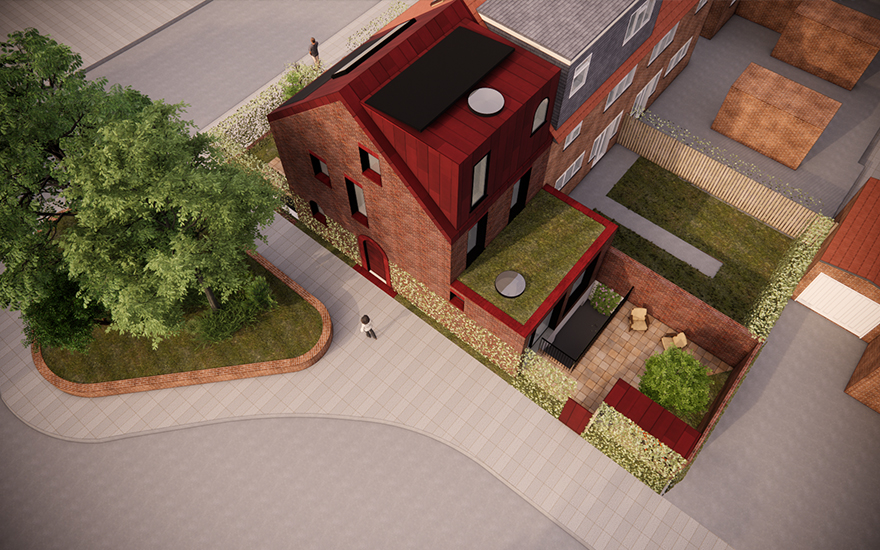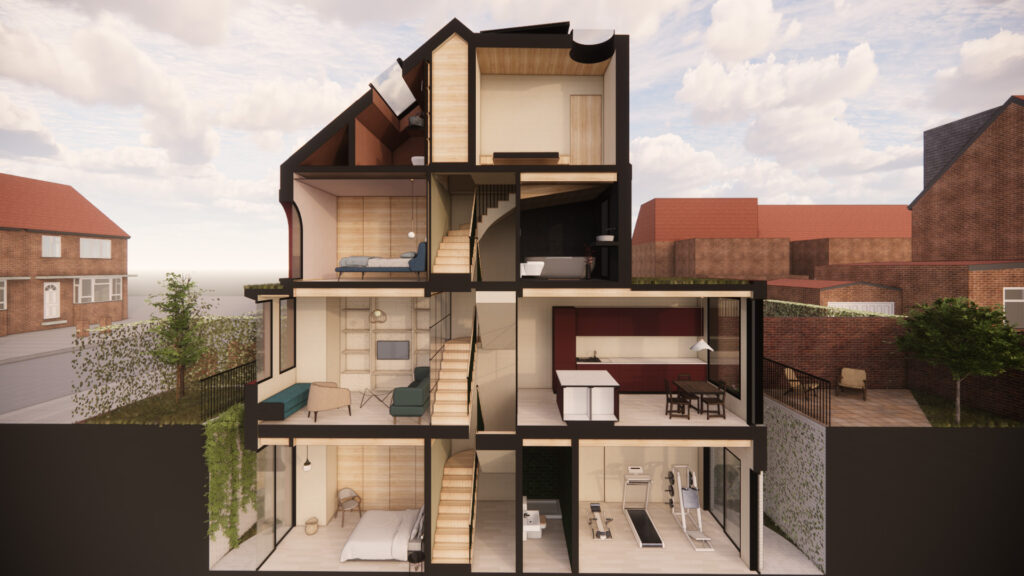Each project we work on teaches us that crafting an energy-efficient, beautiful home, akin to creating a symphony, requires an intricate dance of various elements, each resonating with its unique rhythm. At RISE Design Studio, our chief focus is woven around the harmonious union of contemporary design, low energy consumption, and reduced embodied carbon.
As the real effects of climate change becomes increasingly palpable, the demand for sustainable homes is skyrocketing, compelling both the construction industry and homeowners to modify their stance and tune into the rhythm of the Earth. However, rest assured, constructing a sustainable residence doesn’t mean compromising on visual elegance or the comfort and health of the residents.
The goal of this expanded discourse is to equip you with a more comprehensive understanding of the critical facets that underpin sustainable architecture, and how they align to conjure up the magic of a low-energy, aesthetically pleasing, and sustainable dwelling. The insightful knowledge will prove invaluable as you stride forth to manifest your sustainable, eco-friendly abode.

Harmony in Design: The Passivhaus Standard
Embarking on our journey into the eco-home terrain, let’s first explore the innovative Passivhaus design. This holistic approach to construction aims to build homes that maintain optimal temperatures with minimal energy input, largely leveraging natural resources like sunlight and heat from appliances and human activities.
The Passivhaus ethos hinges on factors such as the home’s dimensions, form, orientation, thermal retention capacity, airtightness, and efficient ventilation and heat-recovery systems. The ultimate aim? A drastic reduction in the dwelling’s yearly carbon footprint.
A crucial part of the Passivhaus equation is ensuring that space heating doesn’t exceed 15 kWh/m². This constraint demands thoughtful consideration of the home’s climatic setting. For instance, in the UK, meeting the Passivhaus standard entails incorporating high-quality insulation, installing high-performance windows with insulated frames, fostering airtightness, creating ‘thermal bridge free’ construction, integrating a highly efficient heat recovery system, and a meticulous design process underpinned by the Passive House Planning Package (PHPP).

Embracing the Sun: Passive Solar Design for Sustainable Homes
Next is the focus on the sun – nature’s most abundant source of energy. Passive solar design allows us to harness the sun’s heat and light directly, reducing the energy requirements of our homes.
Critical to this technique is the orientation of the building. In the northern hemisphere, optimally, the buildings should face south, and windows should predominantly adorn the south side, to maximise solar gain. Existing structures might not permit change in orientation, but retrofitting initiatives can include superior, thermally-efficient triple glazing on the southern side.
But here’s the kicker: while we soak up the sun’s gifts, it’s essential to avoid overheating, especially during summers. Features like extended eaves and strategically positioned blinds can curb high-angle sun penetration without hampering natural light infiltration.
Thermal Alchemy: U Values and Eco-Friendly House Design
Pivoting to the core of the building, we delve into the materials that give it life. The sustainability of a home is deeply rooted in the carbon cost of its construction materials. Options such as sustainably sourced timber, cob, and straw present greener alternatives to traditional, carbon-intensive materials.
A crucial concept that helps us comprehend the thermal efficiency of these materials is the U value, which quantifies the rate of heat escape from a building. A lower U value implies slower heat dissipation, which is a Passivhaus mandate, setting limits on.
Towards the conclusion of this journey into the intricacies of eco-home building, it’s imperative that we answer some of the frequently asked questions you might have concerning the venture. We hope that these answers will illuminate your path as you progress towards constructing a sustainable, visually appealing, and low energy-demanding home.

Frequently Asked Questions
Q1. What is Passivhaus design?
Passivhaus design is a gold standard for energy-efficient homes, aiming to achieve comfort with minimal energy use. It taps into passive energy sources such as sunlight and heat generated from people and appliances to dramatically minimise the need for auxiliary heating.
Q2. How important is building orientation in eco-home design?
Building orientation is critical in sustainable home design. If you’re in the Northern Hemisphere, your home should face south, with most windows positioned on this side to maximise solar gain. Strategic shading can prevent overheating during summer, with solutions like extended eaves and well-positioned external blinds.
Q3. What is the U value in the context of eco homes?
The U value measures the rate at which heat escapes a building. The lower the U value, the slower heat dissipates. Materials with a lower U value help retain heat in the house, reducing the energy needed for heating.
Q4. What is airtight design in eco homes?
Airtight design refers to the practice of ensuring minimal air leakage from a building. In eco homes, an airtight design helps maintain a comfortable temperature by reducing heat loss. It’s achieved by using airtightness tapes and membranes across all elements of the building.
Q5. What is the role of natural ventilation and heat recovery systems in eco homes?
Natural ventilation helps maintain a comfortable temperature by allowing air to flow through the building. Meanwhile, heat recovery systems, often incorporated in airtight designs, help maintain indoor air quality. They extract heat from the warm air in spaces like kitchens and bathrooms, transfer it to fresh incoming air, and release it back into the living areas.
Q6. How can I manage energy use and efficiency in eco homes?
A combination of strategies helps manage energy use and efficiency. These include the use of A+++ rated appliances, LED lighting, and active solar measures, such as photovoltaics, to meet electricity needs. Proper insulation, solar orientation, and efficient hot water heating systems also contribute to energy efficiency.
Q7. How do eco homes handle water, drainage, and waste?
Eco homes incorporate water-saving measures like low-flush plumbing and water recycling systems. They also employ alternative waste management systems, like composting toilets. Heat loss considerations during the installation of water systems and effective handling of household waste, like recycling, are essential aspects.
Q8. How adaptable should an eco home be?
A truly sustainable home should be flexible and ready for different eventualities. In light of our rapidly changing climate, it’s crucial that eco homes require minimal external power to operate and have features that enable them to weather literal and metaphorical storms.
Q9. What role does the environment play in the design of an eco home?
Sustainable home design takes into account the building’s context. A truly zero-carbon home would encourage a zero-carbon lifestyle, including provisions for food production, bicycle storage, flexible workspaces, and other environmentally friendly features.
Our role at RISE Design Studio is to guide you through the exciting journey of creating your eco-home. Equipped with a team of architects and interior designers well-versed in sustainable design principles, we’re more than ready to help make your eco-home dream a reality. Connect with us today and embark on this transformative journey to sustainable living.
If you would like to talk through your project with the team, please do get in touch at mail@risedesignstudio.co.uk or give us a call on 020 3290 1003
RISE Design Studio Architects company reg no: 08129708 VAT no: GB158316403 © RISE Design Studio. Trading since 2011.
